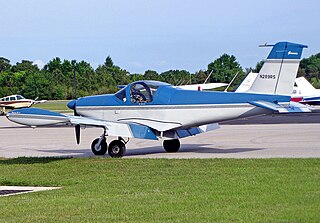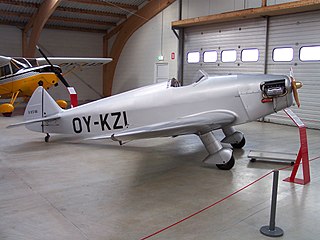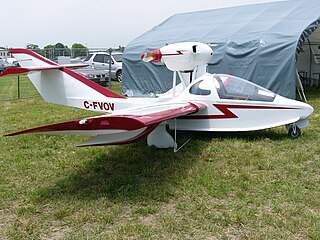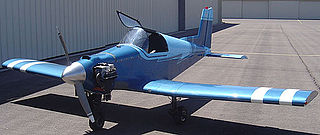Related Research Articles

The Van's RV-6 and RV-6A are two-seat, single-engine, low-wing homebuilt airplanes sold in kit form by Van's Aircraft. The RV-6 is the tail-wheel equipped version while the RV-6A features a nose-wheel. The RV-6 was the first aircraft in the popular Van's RV series to feature side-by-side seating and the first to offer a nosewheel option. It was first flown in 1985. Over 2500 kits have been completed and flown.

The Evans VP-1 Volksplane is an American designed aircraft for amateur construction. The aircraft was designed by former Convair, Ryan Aircraft and General Dynamics aeronautical engineer William Samuel Evans of La Jolla, California.

The Davis DA-2 is a light aircraft designed in the United States in the 1960s and was marketed for homebuilding. While it is a low-wing monoplane of largely conventional design with fixed tricycle undercarriage, the DA-2 is given a distinctive appearance by its slab-like fuselage construction and its V-tail. The pilot and a single passenger sit side-by-side. Construction of the aircraft is sheet aluminum throughout, with the sole compound curves formed a fiberglass cowling and fairings.

The Pazmany PL-1 Laminar and Pazmany PL-2 are American two-seat trainer and personal light aircraft designed by Ladislao Pazmany to be marketed as a homebuilt aircraft by his company Pazmany Aircraft Corporation. The aircraft was built under licence in Taiwan as the AIDC PL-1B Cheinshou. It was later followed by an improved version the PL-2. The SLAF Aircraft Engineering Wing developed a modified variant of the PL-2 in 1977, which never saw combat but was used in air shows.

The Druine D.31 Turbulent is a French single-seat ultralight Homebuilt aircraft designed by Roger Druine.

The Jurca MJ-5 Sirocco is a two-seat sport aircraft designed in France in the early 1960s and marketed for homebuilding. It is one of many wooden homebuilt designs from Romainian born designer Marcel Jurca. Jurca, a Henschel Hs 129 pilot in World War II marketed the plans in Canada and America through Falconar Aviation. It is a low-wing cantilever monoplane of conventional configuration and wooden construction throughout. The tandem seats are enclosed by a bubble canopy, and the tailwheel undercarriage can be built as either fixed or with retractable main units. Marcel Jurca died on 19 October 2001, at which time plans were still available from the designer's web site.

The SAI KZ I was a sport aircraft built in Denmark in 1937, the first aircraft built by the Kramme & Zeuthen firm. It was a low-wing cantilever monoplane of conventional design, with fixed tailwheel undercarriage and an open cockpit with a single seat. Construction throughout was of wood.

The Osprey Osprey 2, also known as the Pereira Osprey 2 after its designer, is an amphibious sport aircraft designed for homebuilding. Plans have been sold since the mid-1970s. George Pereira designed the Osprey 2 to address the two most frequent criticisms of his Osprey I aircraft: its lack of a passenger seat and its inability to operate from dry land. An exercise that began as a series of modifications to the original design in January 1972 eventually turned into a complete redesign of the aircraft, with the resulting Osprey 2 flying in April 1973.

The Parker Teenie Two is a single-seat, single-engine sport aircraft first built in the United States in 1969 and marketed for homebuilding. It is a low-wing, cantilever monoplane of conventional configuration and fixed tricycle undercarriage. The cockpit was designed to be left open, but plans for a canopy to enclose it were made available, the use of which would increase the top speed of the aircraft. The Teenie Two was specifically designed to use a converted Volkswagen automobile engine for power. The outer wing panels can be detached for transport or storage.

The Valentin Taifun is a two-seat self-launching sailplane designed and built by Valentin Flugzeugbau GmbH of Hasfurt, Germany.

The PDQ Aircraft Products PDQ-2 is a very basic light aircraft originally built in 1973 in the United States, and marketed as plans for a homebuilt aircraft. It was a minimalist design, consisting of aluminum alloy tubes carrying the pilot's seat, a set of monoplane wings and a T-tail. The pilot's position was fully exposed at the front of the aircraft. Power is provided by a single engine mounted pusher-fashion on a pylon above the wings. Originally, this was a Rockwell JLO snowmobile engine, but Ison revised the design to use a converted Volkswagen engine, due to a lack of availability of the first choice of engine. The heavier Volkswagen engine required an increase in structural strength, and the design was revised accordingly. The wings have wooden spars with ribs, and skin of polyurethane foam, all coated in epoxy resin. Fixed, tricycle undercarriage was fitted.

The Piel CP.60 Diamant is a single-engine light aircraft designed in France in the 1960s and marketed for home building.

The Rand Robinson KR-1 is a single-seat, single-engine sport aircraft designed in the United States in the early 1970s and marketed for homebuilding. A two-seat version is marketed as the KR-2. It is a low-wing cantilever monoplane of conventional design with an enclosed cockpit and tailwheel undercarriage. As originally designed, the main undercarriage units of the KR-1 and basic KR-2 were manually retractable, folding backwards into the wings, while the KR-2T tandem-seat version had fixed undercarriage. However, some builders choose fixed tailwheel or even fixed tricycle undercarriage for KR-1s and KR-2s.

The Spencer Amphibian Air Car is an American light amphibious aircraft. The name was first used in 1940 for a prototype air vehicle that developed into the Republic Seabee. The name was later used by its designer Percival Spencer for a series of homebuilt amphibious aircraft roughly based on the Seabee design.
The Pazmany PL-9 Stork is an American single-engined high-wing monoplane designed by Ladislao Pazmany as a ¾ scale variant of the Second World War Fieseler Storch for the home builder market.

The SAN Jodel D.140 Mousquetaire (Musketeer) is a French five-seat light touring monoplane based on the earlier Jodel D.117 and built by Société Aéronautique Normande (SAN) at Bernay.

The Smith DSA-1 Miniplane is a single-seat, single-engine sport aircraft designed in the United States in the 1950s and marketed for home building.

The Preceptor N3 Pup is a family of ultralight, tube-and-fabric, high-wing, homebuilt aircraft. Kits were produced and marketed by Preceptor Aircraft, of Rutherfordton, North Carolina. The company was operating on a limited basis, actively selling plans online, but seems to have gone out of business in 2016.

Ladislao Pazmany was an aviation pioneer, aeronautical engineer, designer, builder, pilot, teacher, speaker, and author. Born a Hungarian, Pazmany grew up, went to school and worked in his formative years in Argentina, then immigrated to the United States where he lived for the remainder of his life.
The Sheffield Skeeter X-1 is an American single-seat lightweight homebuilt aircraft designed and built by Kenneth Sheffield of Littleton, Colorado. Designed for amateur construction only the prototype was built.
References
Notes
- ↑ Taylor 1989, p.717
- 1 2 3 4 Jane's All the World's Aircraft 1985–86, p.608
- 1 2 Markowski 1979, p.241
- ↑ "Pazmany's PL-4 Features 'T'-tail and VW engine" 1972, p.40
- ↑ Markowski 1979, p.245
- ↑ "Pazmany's PL-4 Features 'T'-tail and VW engine" 1972, p.43
- ↑ Pazmany 1973, p.39
- ↑ Bayerl, Robby; Martin Berkemeier; et al: World Directory of Leisure Aviation 2011-12, page 114. WDLA UK, Lancaster UK, 2011. ISSN 1368-485X
- ↑ Markowski 1979, p.246
- ↑ Dwiggins 1973, p.78
- ↑ Simpson 2001, p.418
- ↑ Tacke, Willi; Marino Boric; et al: World Directory of Light Aviation 2015-16, page 121. Flying Pages Europe SARL, 2015. ISSN 1368-485X
- ↑ Jane's All the World's Aircraft 1984/5 p.571
Bibliography
- Dwiggins, Don (April 1973). "Pazmany VW-Engine Homebuilt". Plane & Pilot: 76–79.
- Taylor, John W. R. (1984). Jane's All the World's Aircraft 1984-1985. London: Jane's Publishing Co. ISBN 0710608012.
- Jane's All the World's Aircraft 1985–86 . London: Jane's Publications.
- Markowski, Mark (1979). The Encyclopedia of Homebuilt Aircraft. Blue Ridge Summit, Pennsylvania: TAB Books. ISBN 0-8306-2256-X.
- Pazmany, Ladislao (March 1973). "The Pazmany PL-4A is flying". Sport Aviation: 32–39.
- "Pazmany's PL-4 Features 'T'-tail and VW engine". Sport Flying: 40–43. October 1972.
- Simpson, Rod (2001). Airlife's World Aircraft. Shrewsbury: Airlife Publishing Ltd. ISBN 978-1-84037-115-4.
- Taylor, Michael J. H. (1989). Jane's Encyclopedia of Aviation. London: Studio Editions. ISBN 0-7106-0710-5.